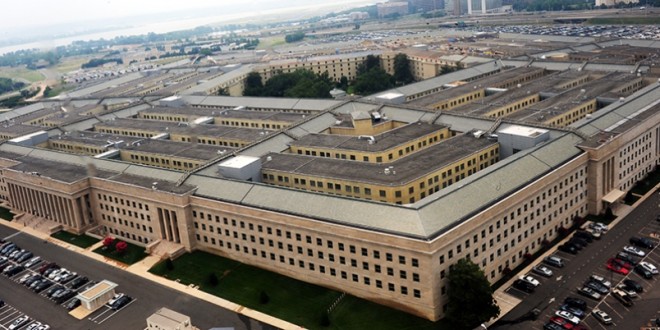
With the House voting again to delay for a year the start of the Affordable Care Act and repealing a tax on medical devices that helps pay for the measure, a partial shutdown of the federal government this week appears nearer. The Senate is expected to take up and reject the bill when it convenes today, likely in the middle of the afternoon.
About 400,000 federal workers, this time including naval shipyard workers, would be furloughed without pay until Congress can reach an agreement on some type of spending bill and send it to President Barack Obama for his signature. As to exactly who is affected and what activities will be allowed to continue, senior officers and managers were still working out the details over the weekend.
Sounding resigned to a government shutdown, Pentagon comptroller Robert Hale delivered the bad news that civilian workers, including the military technicians who keep National Guard and reserve units ready for drill or deployment, were expecting but didn’t want to hear: Don’t come to work Tuesday.
But if you’re wearing a uniform that day, show up.
If Congress can’t agree on a spending plan by around 7 October, don’t necessarily expect to get paid on time if you are on active duty or an “excepted civilian worker.” The pay situation is even more muddled for the reserve components because they are paid at different times of the month, Hale said.
Even before the shutdown, the threat is having an impact on the department, Hale noted. “People are worrying about if their paychecks are going to be delayed rather than focusing on their mission.”
In addition, for survivors of service members who are killed during any government shutdown, payment of death gratuities would have to wait until a spending bill is approved. “We would have no authority to pay the money, and in that case the payment would be delayed.”
An Army spokeswoman said Arlington National Cemetery will remain open, and workers involved in transferring the remains of war dead will stay on the job. VA cemeteries would not be affected by a government shutdown because that department is funded a year in advance.
Hale said the convening of promotion boards also likely will be put on hold.
Military operations in Afghanistan and in other locations where they are considered “necessary for the safety of human life and protection of property” will continue. Deployment and separation orders are not affected. Other temporary travel will not be authorized or subject to a senior officer’s or civilian’s approval if going to and from Afghanistan, for example. Recruiting will continue, and the military entrance and processing stations will remain open.
Speaking Friday at a Pentagon press conference, Hale said, “Unfortunately, we’re pretty good at this”— building plans to furlough about half of its civilian work force and close down everything from commissaries to carrier training flights if the ship is off the Virginia capes rather than sailing in the Mediterranean.
Underlining the point of getting “pretty good at this” from past experience, the Defense Department’s website, as well as those for the Portsmouth and Pearl Harbor Naval Shipyards have a link on the possible shutdown that leads to the December 2011 guidance when it was possible that the federal government would run out of money because no spending plan had been approved.
Similarly, the shipping of equipment out of Afghanistan might be temporarily put on hold, Hale indicated. “I’m not sure where [U.S. commander] General [Joseph] Dunford is on this,” meaning designating the work as “excepted.”
As to how far the shutdown proceeds “in gray areas,” such as moving equipment from Southwest Asia to the United States, Hale said several times, “our commanders and managers are considering those issues right now.”
Off the table in the shutdown, for now, are basic services—dining facilities, fitness centers, child-care centers, and such, the Defense Department said in a release. But looking at what’s opened and what’s closed on an individual installation, the National Military Families Association advised on its website guide to the shutdown: Call ahead and even if open, expect delays.
Hale returned several times to the shutdown lowering the already low morale of Defense Department civilians, 600,000 of whom absorbed six days of furlough this summer, two years of pay freezes and downsizing. The new furloughs would be “one more blow to the morale of our civilian workforce.”
As to why this shutdown differs from the furloughs this summer, Hale said this time decisions are based on law of who is allowed to work, not a policy of cutting costs and shifting funds from one program to another to keep some activities, such as shipyards, functioning.
And there is no guarantee that furloughed workers would receive any pay for the days that were ordered to stay home and not do any work for the government. In the shutdowns during the 1990s, Congress voted to pay furloughed worked retroactively.
Hale didn’t see a brighter future ahead for either DOD civilians and service members even when the current deadlock ends, the debt ceiling is raised, and flexibility returns to managing accounts, even if a Continuing Resolution is in place rather than a budget. “You’re going to see some RIFs [reductions in force] in coming months and involuntary separations of military.”
Looking at contractors, they will continue to work under agreements awarded before appropriations ran out and would continue to work. Hale said new or extended contracts could not be executed.
For more information on shutdown:
http://www.militaryfamily.org/feature-articles/government-shutdown.html
http://www.whitehouse.gov/sites/default/files/omb/memoranda/2013/m-13-22.pdf





